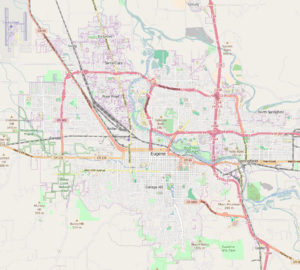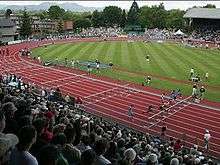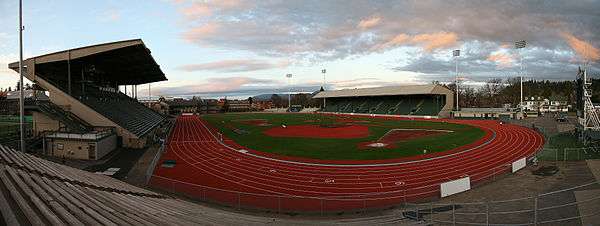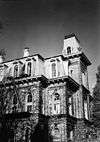Hayward Field
|
2011 Prefontaine Classic | |
 Hayward Field  Hayward Field  Hayward Field | |
| Location |
1580 E. 15th Street Eugene, Oregon, U.S. |
|---|---|
| Coordinates | 44°02′31″N 123°04′16″W / 44.042°N 123.071°WCoordinates: 44°02′31″N 123°04′16″W / 44.042°N 123.071°W |
| Owner | University of Oregon |
| Operator | University of Oregon |
| Capacity |
Old stadium: 10,500 (expandable 21,000) New stadium: 12,900 (expandable to 30,000) |
| Surface |
Natural grass infield (1937–present) Dirt / sawdust (1919–1936) |
| Construction | |
| Broke ground |
1919, 99 years ago 2018, 0 years ago |
| Opened |
1919 – (football) 1921 – (track) 2020 – (new stadium) |
| Architect |
Ellis Lawrence (1925 west grandstand) SRG Partnership (2020 stadium) |
| Tenants | |
|
Oregon Ducks track and field Oregon Ducks football (1919–1966) | |
Hayward Field is a historic track and field stadium in Eugene, Oregon, United States.[1] Nearly a century in age, it has been the home of the University of Oregon's track and field teams since 1921, and was the on-campus home of the varsity football team from 1919 through 1966.[2]
Hayward Field was named after track coach Bill Hayward (1868–1947),[3] who ran the Ducks' program from 1904 to 1947.[4] Renovated in 2004, it is one of only five International Association of Athletics Federations Class 1 certified tracks in the United States (along with Hutsell-Rosen Track, Icahn Stadium, John McDonnell Field and Rock Chalk Park). The elevation of Hayward Field is approximately 420 feet (130 m) above sea level and its infield has a conventional north-south orientation. The Pacific Ocean is approximately fifty miles (80 km) to the west, separated by the Coast Range.
In 2018, the stadium will be demolished and rebuilt on the same site. The new stadium, which is expected to reopen in 2020, will be financed by UO's philanthropic community. Phil Knight will be the main donor.[5]
Early years
Hayward was built 99 years ago in 1919 to replace Kincaid Field, and was intended to primarily serve the school's football program.[6][7][8] During halftime of the season opener that year, the venue was named for track coach Hayward; he was busy working as the team's trainer during the break, and did not know of the honor until the following day.[4] In 1921, a six-lane cinder track was constructed around the football field.[7] Renowned architect Ellis F. Lawrence designed the west grandstand, which opened in 1925.[9] A natural grass field was first installed at Hayward Field in 1937; the surface was previously a mixture of dirt and sawdust.[10][11][12] That field surface was not unique in the Northwest in the Pacific Coast Conference: Bell Field in Corvallis, Multnomah Stadium in Portland, and Husky Stadium in Seattle made similar transitions to natural grass in this period of time.[11]
For most of its existence as a football venue, it was notorious for its poor playing conditions in rainy weather. The field didn't drain very well even after the switch to grass, and often turned to mud.
In 1949, a 28-row grandstand in the south end zone was constructed; with temporary bleachers in adjacent corners, the venue's capacity was raised to 22,500 for football.[13] By the 1960s, the football team had long since outgrown Hayward Field; outside of the Civil War game with Oregon State, the Ducks played their higher-attended home games at Portland's Multnomah Stadium, 110 miles away. The final varsity football game was played in November 1966;[2][14] the new Autzen Stadium opened in September 1967,[15] and Hayward Field became a facility solely for track and field,[7] except for a few freshman team football games.[16]
Eight lanes
The track was widened to eight lanes in late in the summer of 1969 and converted to an all-weather surface that autumn.[17][18] Its first synthetic track was Pro-Turf,[18] a urethane and sand composite which led to a hard and fast surface; it produced many world records and gained a reputation as the world's fastest track.[19] Light in color, it was resurfaced with the same in 1976.[20]
New west grandstand
Decayed and in disrepair,[21][22][23][24] the original west grandstand was built in 1925 and its roof added in 1938.[25] It was demolished in September 1973,[26][27] and the finish line (for most events) was moved to the track's northeast corner for the 1974 season.[28] The new west grandstand, also made of wood with a capacity of 4,300 spectators, was ready for use in March 1975.[29] The Prefontaine Classic originated as the "Hayward Field Restoration Meet" in 1973,[24][30] to help raise funds for a new west grandstand.[31][32][33]
Metric
The track was converted to metric in the summer of 1987, its lap length changed from 440 yards (402.336 m) to 400 meters, a reduction of 2.336 m (7 ft 8.0 in). The geometry of the track was changed to the international configuration, with shorter straights and longer turns. This widening of the infield required the relocation of the 300-foot (90 m), 500-ton east grandstand, which was raised and moved 35 ft 9.5 in (10.91 m) east in March.[34] The surface was again Pro-Turf, but with different surface properties; a textured top layer and a reddish color.[20] In addition, a 200 m warmup track was added to the southwest of the main track, along with a new hammer throw area and a weight room facility. A state-of-the-art scoreboard was added in 1991, which gave unofficial times and competitors' placings just seconds after race completion.[7] This project was completed with a great deal of help from the Oregon Track Club as well as the efforts of many others. Bill McChesney SR who is the father of the Oregon 5K record holder and 1980 Olympian, Bill McChesney, was president of the OTC at the time and was one of the key members of the community that made this project possible.
Bowerman Building

After a donation in 1990 by Bill Bowerman (1911–1999),[35] UO's longtime track coach (1948–1973), the 15,000-square-foot (1,400 m2) Bowerman Building was added to the northwest of the track, housing locker rooms, U of O track memorabilia and the university's International Institute for Sport and Human Performance.[7] Bowerman began a public jogging program at Hayward Field in 1963 after a visit to New Zealand, inspired by coach Arthur Lydiard.[36]
Renovation
A major renovation in 2004 added a new entrance named Powell Plaza. It also moved the practice track, expanded it to 400 meters, and replaced the aging fencing bordering the complex. After Hayward Field was awarded the 2008 U.S. Olympic Trials, it underwent additional renovations in 2007. Eight light poles were installed for televised night events, and the crowned infield was removed and reconfigured. A walkway was added behind the west grandstand, and a new scoreboard was installed, thanks to a donation by alumnus Phil Knight and Nike.[7]
On April 17th, 2018 it was announced that starting in the Summer of 2018 and ending in 2020, Hayward field would undergo a major renovation. The renovation would demolish both current grandstands and establish a whole new stadium around the track with a capacity of 12,900 that is expandable to nearly 30,000 for events like the US Olympic Trials and NCAA National Championships.
Major competitions

Hayward Field has hosted USATF championships in 1986, 1993, 1999, 2001, 2009, 2011, and 2015 and the Olympic trials in 1972, 1976, 1980, 2008, 2012, and 2016. It has been the site of numerous NCAA championships, USATF Elite Running Circuit events, and the annual Nike Prefontaine Classic.[37]
The World Junior Championships were held at Hayward Field in 2014, and the World Championships are slated to be held there in 2021.[38] The stadium is scheduled to undergo a major overhaul after the 2018 track season and could accommodate 30,000 spectators at the event.
In film
Hayward Field appeared in a fictionalized staging of the Olympic trials for the 1982 film Personal Best, in the 1998 biography of Steve Prefontaine Without Limits, and Alexi Pappas's 2016 film Tracktown. It is also in the background of the ROTC drill scene of the 1978 film Animal House.
Notable athletes

at the 2006 Prefontaine Classic
Oregon Ducks who competed at Hayward Field
- Kelly Blair
- Dyrol Burleson
- Rudy Chapa
- Joaquim Cruz
- Otis Davis
- Lance Deal
- Jenna Prandini
- Bill Dellinger
- Ashton Eaton
- Russ Francis
- Jim Grelle
- Claudette Groenendaal[39]
- Jordan Hasay
- Harry Jerome
- Daniel Kelly
- Phil Knight
- Kenny Moore
- Bill McChesney
- Steve Prefontaine
- Mel Renfro
- Mack Robinson
- Devon Allen
- Deajah Stevens
- Galen Rupp
- Alberto Salazar
- Jerry Tarr
- Andrew Wheating
- Mac Wilkins
- Alexi Pappas
- Brianne Theisen-Eaton
References
- ↑ "Traditions are time-tested at historic Hayward Field" Denver Post, 27 June 2008
- 1 2 Tims, Marvin (November 6, 1966). "Hayward Field ends its days on sad note". Eugene Register-Guard. Oregon. p. 1A.
- ↑ Strite, Dick (December 15, 1947). "Illness fatal to Col. Bill". Eugene Register-Guard. Oregon. p. 1.
- 1 2 Newnham, Blaine (June 22, 1980). "Pages out of time". Eugene Register-Guard. Oregon. p. 1D.
- ↑ "Hayward Field Renovation Fact Sheet". Hayward Field Renovation. University of Oregon. Retrieved April 19, 2018.
- ↑ "Kincaid Field". University of Oregon. Retrieved July 7, 2010.
- 1 2 3 4 5 6 "Hayward Field". GoDucks.com. Retrieved 2007-10-30.
- ↑ McCann, Michael C. (1995). Oregon Ducks Football: 100 Years of Glory. Eugene, Oregon: McCann Communications Corp. ISBN 0-9648244-7-7.
- ↑ "History of Hayward Field -Sports History". UO Libraries. Retrieved 18 April 2018.
- ↑ Simpson, Ned (August 30, 1936). "Highclimber looks 'em over". Eugene Register-Guard. Oregon. p. 10.
- 1 2 Strite, Dick (December 11, 1936). "University of Oregon plans for turfing of Hayward Field; Callison re-recommended coach". Eugene Register-Guard. Oregon. p. 14.
- ↑ Strite, Dick (October 3, 1937). "Oregon defeats Stanford 7-6 in sparkling game". Eugene Register-Guard. Oregon. p. 1.
- ↑ "Hayward Field renovation underway with new seats". Eugene Register-Guard. Oregon. July 31, 1949. p. 10A.
- ↑ Uhrhammer, Jerry (November 6, 1966). "Ducks lose count, game". Eugene Register-Guard. Oregon. p. 1B.
- ↑ Bishoff, Don (September 24, 1967). "First game in new stadium proved 'hot one' for fans". Eugene Register-Guard. Oregon. p. 1A.
- ↑ Tims, Marvin (September 17, 1967). "Semi-retired Hayward Field still to play important role for university". Eugene Register-Guard. Oregon. p. 6A.
- ↑ "New Hayward track construction begins". Eugene Register-Guard. Oregon. (photo). September 12, 1969. p. 1C.
- 1 2 "Hayward Field track takes on a new look". Eugene Register-Guard. Oregon. (photo). October 23, 1969. p. 1D.
- ↑ Newnham, Blaine (June 15, 1975). "Anatomy of the world's fastest track". Eugene Register-Guard. Oregon. p. 1B.
- 1 2 Kayfes, Dave (July 31, 1987). "Hayward's new 400-meter oval set for pouring". Eugene Register-Guard. Oregon. p. 1B.
- ↑ "Hayward Field renovation completion eyed Saturday". Eugene Register-Guard. Oregon. April 10, 1970. p. 2B.
- ↑ "Volunteers repair Hayward Field". Eugene Register-Guard. Oregon. April 12, 1970. p. 2B.
- ↑ Newnham, Blaine (July 12, 1972). "Looking ahead". Eugene Register-Guard. Oregon. p. 1D.
- 1 2 Newnham, Blaine (August 10, 1973). "Still short of the goal". Eugene Register-Guard. Oregon. p. 1D.
- ↑ Paseman, Lloyd (February 21, 1973). "Hayward Field rehabilitation recommended by state board". Eugene Register-Guard. Oregon. p. 1D.
- ↑ Paseman, Lloyd (August 28, 1973). "Final OK given for grandstands". Eugene Register-Guard. Oregon. p. 1B.
- ↑ "Bowerman: Hayward Field answer may be natural look". Eugene Register-Guard. Oregon. December 11, 1973. p. 3B.
- ↑ Conrad, John (March 29, 1974). "A flip-flop at Hayward Field will produce strange finishes". Eugene Register-Guard. Oregon. p. 2B.
- ↑ Conrad, John (March 20, 1975). "Ducks, stands await unveiling". Eugene Register-Guard. Oregon. p. 2D.
- ↑ Conrad, John (June 21, 1973). "Wottle (3:53.3) still king of the milers". Eugene-Register Guard. Oregon. p. 1B.
- ↑ Withers, Bud (June 9, 1974). "Wohlhuter keeps his word: 1:44.1". Eugene-Register Guard. Oregon. p. 1C.
- ↑ Bellamy, Ron (May 25, 1999). "Silver Pre". Eugene-Register Guard. Oregon. p. 1B.
- ↑ Kayfes, Dave (May 29, 1978). "Ins and outs". Eugene-Register Guard. Oregon. p. 1B.
- ↑ Collias, Rob (March 16, 1987). "Hayward grandstand jogs east". Eugene Register-Guard. Oregon. p. 1A.
- ↑ Bellamy, Ron (November 17, 1990). "Bowerman to finance complex". Eugene Register-Guard. Oregon. p. 1B.
- ↑ "Jogging for Everyone". Retrieved 2012-05-14.
- ↑ "Eugene awarded 2008 Olympic Track & Field Trials". USATF. 2005-10-14. Retrieved 2007-04-04.
- ↑ "Eugene awarded 2021 IAAF World Championships".
- ↑ http://www.goducks.com/searchresults.aspx?cx=016306950182310286156:89osnt54u_k&q=claudette%20groenendaal&sa=Search&cof=FORID%3A11#1141
External links
| Wikimedia Commons has media related to Hayward Field. |
